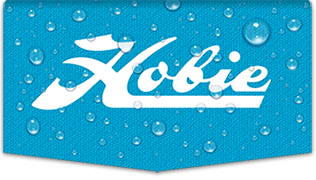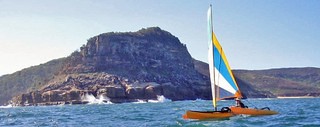|
I ran some tests yesterday both tacking and gybing just after passing to windward of a fixed buoy to reference the relative position after the maneuver. The winds were 15+ knots with frequent wind driven white caps, but no waves or swells. No drive and the daggerboard was raked back about 45 degrees, and I tried both full sail and furled just short of the h in hobie with pretty similar results. Tacking took about 10-17 seconds, including any backing, if necessary (which usually only took about 5 seconds). The boat finished the maneuver about 5-10 feet further to windward of the buoy (since tacking is turning into the wind, you initially gain distance to windward, but lose a little of that due to drift, especially if backing is required). Gybing took about 16-20 seconds with the boat finishing about 30-40 feet to leeward of the buoy. So, if one is able to complete tacks in a somewhat fluid motion, I think tacking wins. I tried to analyze my tacking technique and will outline it below, if anyone is interested in trying it out.
Furled sail in heavy wind, or full sail in moderate wind without large swells:
1. Have good boat speed.
2. Turn into wind eventually reaching full rudder.
3. As soon as the nose hits the eye of the wind and sail luffs, let the sheet out as much as it wants up to about an arm length (perhaps 2-3 feet).
4. Watch the nose of the boat in comparison to the horizon to make sure the boat is continuing to turn (once it gets past about 20 degrees beyond the eye of the wind it will just get blown around as long as the sail is slack).
5a. If the boat keeps turning, then keep holding the rudder. When the nose gets close to the new direction, start to pull in the sail in a smooth, long motion. The initial pull will start the boat forward and complete the turn.
5b. If the boat stops turning (this usually will happen right after the boat passes the eye of the wind. where the wind is blowing so hard that the boat stops any forward momentum), then immediately reverse the rudder full to the other side and let the sheet be free (however much is needed to let the sail luff during the whole turn). You know your timing is right if you almost immediately notice the boat continuing to turn. Timed right, this is almost one continuous motion. Keep holding the rudder in reverse until you PASS the direction you want be going. Then slowly pull the sail in and, as forward motion starts, then reverse the rudder again, but not too much, turning away from the wind slightly.
6. Ease off the rudder. Don't finish sheeting in until you are back up to speed. Then turn back into the wind to your proper course.
Full sail in heavier air:
Everything is mostly the same, except most people don't get how to get good boat speed. In heavy air, when sheeted in tight, the boat naturally pinches higher into the wind than it should. Either one constantly fights this by bearing of in lulls and being brought back up in gusts. Or, one just gives in and the boat moves forward at what seems like an OK pace. One thinks they are sailing well, because the boat is moving forward and is pointing in a favorable direction (close to the wind). But, if you were to track your actual course (drag a polypropylene floating line behind the boat to measure this) you will see that you are actually slipping sideways pretty rapidly. Your effective motion is more than 5 degrees off of where you are pointing (possibly 10-15 degrees). If you try to tack at this boat speed, you will rarely make it past the eye of the wind, because you just don't have enough forward momentum. Now, on a Hobie Cat, in these conditions, we would ease the traveler out a bit. Since we don't have travelers, you have to ease the sheet. It doesn't take much, only a couple inches or so. Once, you have eased the sheet, you will find it much easier to bear off and hold that course. Your speed will increase substantially and you won't slip sideways as much. In fact, if you tracked you actual motion, you will be moving closer to the wind then when you were pulled in tight AND you will be traveling much faster. This is a much more efficient way to sail upwind in heavy air (as is furling the sail) and you will almost always have enough boat speed to make it past the eye of the wind during a tack.
Waves:
Remember that the goal is to be able to turn past the eye of the wind BEFORE the boat starts moving backwards. If you accomplish that, then reversing the rudder will bring the boat around pretty quickly. If not, either you accept defeat and return to your original heading, or you will be adrift in limbo for a long time, which isn't that comfortable if there are waves. Also, note that when you are going up a wave, your forward motion is slowed, or you may even be pushed backward. When going down the back of a wave, you are sped up slightly.
1. Have VERY good boat speed (see above).
2. Watch the waves to make the tack when the waves are smaller and further apart (if this is possible).
3. Time the turn. Just as a wave is passing under you, as it passes under the mast, that's when you BEGIN your turn (perhaps a little sooner depending on how close together the waves are). Your goal is to get the nose past the eye of the wind BEFORE it starts climbing the next wave.
4. Pay attention to whether you are still turning as you climb the next wave. If the waves are larger, or if it's windy, you will almost surely be stopped or moving backwards in which case you won't be turning. In this case, immediately reverse the rudder and continue on as described above. Experience will tell you the conditions that reversing rudder is necessary. In those cases, you just anticipate, and almost always reverse as soon as you start climbing the next wave.
Once again, in order to succeed at tacking, your initial turn has to get you past the eye of the wind. At that point, it is possible to complete the tack in a fluid series of steps. If you can't get up enough boat speed, or it's just too windy, or the waves are just too big to get the initial turn far enough, then I suppose gybing is an alternative. But, IMO, you probably shouldn't be out in those conditions and gybing in those conditions can get dangerous.
BTW-If it is done within a fluid series of steps, I don't consider the rudder reversal a blown tack. To me a blown tack is either when you don't make it and fall back to the original course, or you reach a point where there is uncertainty and the boat begins to drift without your full control. If a reversal is well timed, you don't lose much time or distance. You completely lose forward speed but these boats accelerate quickly, so that loss is minimal. As I mentioned previously, when racing Hobie 14's in near gale force winds and 15-20 foot seas, reversing the rudder was just accepted as the only way to tack (as was climbing all the way to the front of the boat and praying the boat wouldn't pitchpole backwards in the process of backing). We all tried gybing in those conditions and almost always pitchpoled when the sail flew to the other side (you really had to time it with the waves).
Good luck and good sailing!
|







